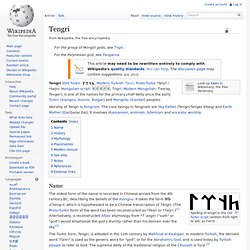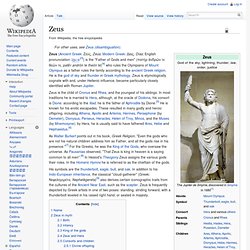

Bochica. Bochica is a figure in the mythology of the Muisca (Chibcha) culture, which existed during the arrival of the Spanish conquistadores in areas comprising parts of present day Colombia and Panama.

He was the founding hero of their civilization, who according to legend brought morals and laws to the people and taught them agriculture and other crafts.[1] Similarly to the Incan god Viracocha, the Aztec god Quetzalcoatl and several other deities from Central and South American pantheons, Bochica is described in legends as being bearded. The beard, once mistaken as a mark of a prehistoric European influence and quickly fueled and embellished by spirits of the colonial era, had its single significance in the continentally insular culture of Mesoamerica. The "Anales de Cuauhtitlan" is a very important early source which is particularly valuable for having been originally written in Nahuatl. Dyaus Pita. Dyauṣ Pitrā (Dyauṣpitṛ द्यौष्पितृ), literally "Sky Father" is the ancient sky god of Vedic pantheon, husband of Prithivi and father of Ushas (Dawn), Ratri (night) and the chief deities.

In the Rigveda, Dyaus Pita appears only in verses 1.89.4, 1.90.7, 1.164.33, 1.191.6 and 4.1.10, and only in RV 1.89.4 does Pitar Dyaus "Father Sky" appear alongside Mata Prithvi "Mother Earth". He is thus a very marginal deity in Rigvedic mythology, but his intrinsic importance is visible from his being the father of the chief deities.
That Dyaus was seen as the father of Indra is known only from one verse, RV 4.17.4: "Thy Father Dyaus esteemed himself a hero: most noble was the work of Indra's Maker / His who begat the strong bolt's Lord who roareth, immovable like earth from her foundation. " (trans. See also[edit] References[edit] Thomas Oberlies, Die Religion des Rgveda, Wien (1998). Horus. Horus is one of the oldest and most significant deities in ancient Egyptian religion, who was worshipped from at least the late Predynastic period through to Greco-Roman times.

Different forms of Horus are recorded in history and these are treated as distinct gods by Egypt specialists.[1] These various forms may possibly be different perceptions of the same multi-layered deity in which certain attributes or syncretic relationships are emphasized, not necessarily in opposition but complementary to one another, consistent with how the Ancient Egyptians viewed the multiple facets of reality.[2] He was most often depicted as a falcon, most likely a lanner or peregrine, or as a man with a falcon head.[3] Etymology[edit] Horus was also known as Nekheny, meaning "falcon".
Some have proposed that Nekheny may have been another falcon-god, worshipped at Nekhen (city of the hawk), with which Horus was identified from early on. Note of changes over time[edit] Jupiter (mythology) Rangi and Papa. Papa and Rangi held each other in a tight embrace In Māori mythology the primal couple Rangi and Papa (or Ranginui and Papatuanuku) appear in a creation myth explaining the origin of the world.

In some South Island dialects, Rangi is called Raki or Rakinui.[1] Shangdi. This article is about the ancient Chinese deity 上帝.

For the related later deities, see Tian and the Jade Emperor. For the unrelated Beijing subway station, see Shangdi Station. Shangdi or Shang-ti (Chinese: 上帝; pinyin: Shàngdì), also written simply as Di or Ti (Chinese: 帝; pinyin: Dì; "Emperor"), is a supreme god and sky deity in China's traditional religions. Tengri. For the group of Mongol gods, see Tngri.

Tengri (Old Turkic: ; Modern Turkish: Tanrı; Proto-Turkic *teŋri / *taŋrɨ; Mongolian script: ᠲᠨᠭᠷᠢ, Tngri; Modern Mongolian: Тэнгэр, Tenger), is one of the names for the primary chief deity since the early Turkic (Xiongnu, Hunnic, Bulgar) and Mongolic (Xianbei) peoples. Worship of Tengri is Tengrism. The core beings in Tengrism are Sky-Father (Tengri/Tenger Etseg) and Earth Mother (Eje/Gazar Eej).
It involves shamanism, animism, totemism and ancestor worship. Urtzi. Urtzi (also ortzi) is a Basque term that has no convincing explanation as yet.

It either represents an old common noun for the sky, or is the name for a pre-Christian sky deity.[1][2] The Urtzi controversy[edit] The existence of a Basque mythological figure, Urtzi, has been questioned in numerous discussions. The argument for Urtzi being a Basque sky god is based on two main arguments. Wākea. "Wakea" redirects here.

For the frog genus proposed as separate from Mantidactylus, see Mantidactylus. In Hawaiian mythology, Wākea is a god of the sky, the eldest son of Kahiko ("Ancient One"), and lives in Olalowaia. He is the ancestor of the aristocracy (alii) and grandson of Welaahilaninui. The priests and common people come from his brothers, one of whom was called Makuʻu. Wākea's first high priest was called Komoʻawa.[1] When Wākea was on Earth in ancient times, he was a High Chief.
Consorts[edit] In one legend, Wākea lives in Hihiku and marries Papahānaumoku, who is a princess of Olalo-i-mehani and a granddaughter of Princess Kaoupe-alii. Family[edit] Zeus. Name The Chariot of Zeus, from an 1879 Stories from the Greek Tragedians by Alfred Church.

The god's name in the nominative is Ζεύς Zeús /zdeús/. It is inflected as follows: vocative: Ζεῦ / Zeû; accusative: Δία / Día; genitive: Διός / Diós; dative: Διί / Dií. Diogenes Laertius quotes Pherecydes of Syros as spelling the name, Ζάς.[10]